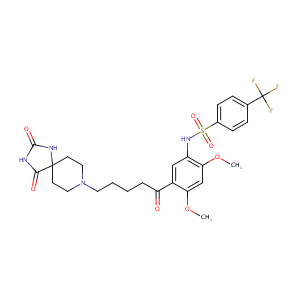Details of the Drug
General Information of Drug (ID: DMHDYBN)
| Drug Name |
RS-102,221
|
|||||||||||||||||||
|---|---|---|---|---|---|---|---|---|---|---|---|---|---|---|---|---|---|---|---|---|
| Synonyms |
RS-102221; RS102221; 185376-97-0; RS 102221 HCl; Tocris-1050; RS-102,221; Biomol-NT_000133; AC1MW45U; GTPL187; CHEMBL88402; SCHEMBL7107338; BPBio1_000243; RS102221 HCl; CHEBI:93519; BDBM85098; HZZZZODVDSHQRG-UHFFFAOYSA-N; BCP03496; ZINC26580328; PDSP1_001633; PDSP2_001617; NCGC00024967-02; NCGC00024967-01; L000523; BRD-K87048468-003-01-9; N-{5-[5-(2,4-dioxo -1,3,8-triazaspiro[4.5]dec-8-yl)pentanoyl]-2,4-dimethoxyphenyl}-4-trifluoromethylbenzenesulfonamide
|
|||||||||||||||||||
| Indication |
|
|||||||||||||||||||
| Drug Type |
Small molecular drug
|
|||||||||||||||||||
| Structure |
 |
|||||||||||||||||||
| 3D MOL | 2D MOL | |||||||||||||||||||
| #Ro5 Violations (Lipinski): 3 | Molecular Weight (mw) | 612.6 | ||||||||||||||||||
| Topological Polar Surface Area (xlogp) | 2.7 | |||||||||||||||||||
| Rotatable Bond Count (rotbonds) | 11 | |||||||||||||||||||
| Hydrogen Bond Donor Count (hbonddonor) | 3 | |||||||||||||||||||
| Hydrogen Bond Acceptor Count (hbondacc) | 12 | |||||||||||||||||||
| Chemical Identifiers |
|
|||||||||||||||||||
| Cross-matching ID | ||||||||||||||||||||
Molecular Interaction Atlas of This Drug
 Drug Therapeutic Target (DTT) |
|
||||||||||||||||||||||||||
|---|---|---|---|---|---|---|---|---|---|---|---|---|---|---|---|---|---|---|---|---|---|---|---|---|---|---|---|
| Molecular Interaction Atlas (MIA) | |||||||||||||||||||||||||||
Molecular Expression Atlas of This Drug
| The Studied Disease | Discovery agent | |||||||||||||||||||||||||||||
|---|---|---|---|---|---|---|---|---|---|---|---|---|---|---|---|---|---|---|---|---|---|---|---|---|---|---|---|---|---|---|
| ICD Disease Classification | N.A. | |||||||||||||||||||||||||||||
|
||||||||||||||||||||||||||||||
| Molecular Expression Atlas (MEA) | ||||||||||||||||||||||||||||||
References
